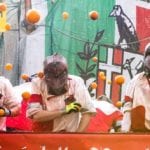 Weird Stuff
Weird Stuff  Weird Stuff
Weird Stuff  Mysteries
Mysteries 10 Tragic Disappearances and Deaths in Joshua Tree National Park
 History
History 10 Ways Childhood Really Sucked in the Old West
 Music
Music 10 Name Origins of Famous Bands from the 1990s
 Religion
Religion 10 Biggest Turnarounds by the Catholic Church
 Weird Stuff
Weird Stuff 10 Unbelievable Times Laws Had Unintended Consequences
 Humans
Humans Ten Historic Women Who Deserve Way More Credit Than They Got
 Movies and TV
Movies and TV 10 Films That Spawned Major Lawsuits
 History
History Ten Times Towns Were Wiped Off the Face of the Earth
 Creepy
Creepy 10 of the Most Disturbingly Haunted Public Houses in the UK
 Weird Stuff
Weird Stuff 10 Niche Subcultures That Are More Popular Than You Might Think
 Mysteries
Mysteries 10 Tragic Disappearances and Deaths in Joshua Tree National Park
 History
History 10 Ways Childhood Really Sucked in the Old West
Who's Behind Listverse?

Jamie Frater
Head Editor
Jamie founded Listverse due to an insatiable desire to share fascinating, obscure, and bizarre facts. He has been a guest speaker on numerous national radio and television stations and is a five time published author.
More About Us Music
Music 10 Name Origins of Famous Bands from the 1990s
 Religion
Religion 10 Biggest Turnarounds by the Catholic Church
 Weird Stuff
Weird Stuff 10 Unbelievable Times Laws Had Unintended Consequences
 Humans
Humans Ten Historic Women Who Deserve Way More Credit Than They Got
 Movies and TV
Movies and TV 10 Films That Spawned Major Lawsuits
 History
History Ten Times Towns Were Wiped Off the Face of the Earth
 Creepy
Creepy 10 of the Most Disturbingly Haunted Public Houses in the UK
Top 10 Food Fights In History
History is filled with examples of powerful people and nations settling their differences through warfare. But sometimes, instead of guns and tanks, victory is reached through fruits and veggies. These lesser-known battles, debates, festivals, and contests have all revolved around the throwing of food.
10 Corn Diplomacy
Nikita Khrushchev, the Soviet leader who spearheaded the Cuban Missile Crisis, really loved corn. He made it his mission to plant corn across Siberia and even established a corn institute in Ukraine.
To learn more about the corn belt in America’s Midwest, Krushchev’s agricultural staff visited the farm of Roswell Garst, a farmer who was interested in bringing his hybrid corn seeds to the Soviet market.
The staff took interest, and Garst traveled to the USSR to meet with more Soviet officials. In 1959, Khrushchev visited the US and returned the courtesy by going to Garst’s farm.
Of course, the visiting Soviet premier attracted lots of media attention, which Garst didn’t appreciate on his property. So he took the mature route and threw husks of hybrid corn at reporters and photographers. Khrushchev was heartily amused.
However, corn diplomacy didn’t work out as Khrushchev had hoped. The Siberian steppes weren’t as fertile as Iowa, and Soviet farmers weren’t adept with Garst’s methods. In Khrushchev’s own words: “Corn was discredited, and so was I.”
9 Taiwanese Lawmaking
In recent years, US citizens have lost confidence in Congress, whose members seem to do little except argue and achieve gridlock. In March 2016, approval ratings for Congress dropped to a mere 13 percent. But American citizens might disapprove even more of the Legislative Yuan, Taiwan’s congress.
The Legislative Yuan has a history of using more than words in their floor debates. The video above shows one instance of an all-out floor fight which came from a disagreement about a trade pact with China.
This type of behavior is commonplace in the Legislative Yuan. In fact, this legislative body is so well-known for its brawls that it was awarded the Ig Nobel Peace Prize, a satirical version of the Nobel Prize.
Despite this record of violence, only one food fight has occurred so far—when the legislature was debating arms sales in October 2004. It isn’t clear who started the fight, but the Legislative Yuan engaged in hurling their lunches for a few minutes. After the fight, Chu Fong-chi, a member of the opposition party, reportedly yelled, “My whole body smells like a lunch box!”
8 Tootsie Rolls
This isn’t so much a food fight as a serious fight that became centered on food during the Korean War. In winter 1950, US Marines and UN allied forces found themselves cornered in the bitter cold of the Chosin Reservoir. They were massively outnumbered by over 100,000 Chinese troops.
The Americans were short on supplies, so they radioed for ammunition. The code word for 60 mm mortars was “Tootsie Rolls.” In a seeming disaster, the radio operator misunderstood the request. Actual Tootsie Rolls from supply bases in Japan were airlifted to the struggling troops.
However, the Tootsies proved to be immensely useful. Marines thawed the candies in their armpits, sucked on them for nourishment, and used the sticky remainders to plug holes in their equipment.
Fighting their way to the sea against the enemy Chinese, the Chosin soldiers moved along 130 kilometers (80 mi) of narrow road, dropping thousands of Tootsie Roll wrappers in the North Korean snow on the way.
They sustained heavy losses—3,000 out of 15,000 troops were killed in action and thousands more were wounded—but they made it. Many credited their survival to the Tootsie Rolls.
7 Cod Wars
Britain has a proud history of getting violently involved in everybody’s business. British troops have invaded, controlled, or fought in almost 90 percent of UN member states. So it should come as no surprise that the Royal Navy was dispatched in a fight over fish.
To be fair, the British were provoked. Iceland, with few natural resources on its mainland, depends heavily on the fishing industry. In fact, fishing accounts for at least 12 percent of the Icelandic GDP.
So when Iceland gained its independence in 1944, it decided to help out the fishers by extending its territorial boundary from 5 kilometers (3 mi) to 6 kilometers (4 mi). As the UK is about 1,300 kilometers (800 mi) from Iceland, this wasn’t a problem. Right?
Wrong.
Britain brought the 2-kilometer (1 mi) extension to the International Court of Justice and was forced to concede. Following this, Iceland began slowly expanding its fishing zone, eventually reaching the current radius of 320 kilometers (200 mi). The British fought every extension, leading to three Cod Wars between 1958 and 1976.
Thankfully, both irate nations managed to keep the violence to a minimum. Throughout the long stretch of diplomatic strife and naval presence, each side suffered only a single casualty. Britain was eventually forced diplomatically to allow Iceland to expand its boundaries.
6 La Tomatina
From the country that stages the Running of the Bulls, Spain gives us La Tomatina, another hard-to-understand tradition. As part of an annual festival in Bunol, Spain, thousands of people gather on the streets for a massive tomato fight on the last Wednesday of every August.
The tradition began in 1945, although it’s uncertain exactly how it started. Some sources cite an accidental tomato fight between two young boys that grew into a town-wide event. Others claim that it began when citizens angrily threw tomatoes at politicians.
However it began, La Tomatina has grown into a shockingly large event. Almost 145,000 kilograms (320,000 lb) of tomatoes were thrown at the 2015 festival. As a whole, the week-long festival attracts about 40,000 visitors—temporarily quadrupling Bunol’s population—with 22,000 tickets to the tomato fight sold in 2015.
After the hour-long frenzy, the streets are caked with tomato paste, so fire trucks hose them down. Participants are responsible for their own cleanup, with many wearing goggles and swimsuits to the event to aid this process.
5 Greek Yogurt
In America, Greek yogurt is a healthy breakfast fad. In Greece, it’s a symbol of political resistance.
In the 1950s, a male subculture known as the “Teddy Boys” initiated the practice of yaourtama, which is throwing yogurt at a disliked person. Authorities weren’t a fan of the practice, and Law 4000 was passed in 1958 to deal with it.
Law 4000 enacted a strange punishment for youths who threw yogurt at others. They were given buzz-cuts, had their shorts torn, and then were paraded through the streets. Since the Teddy Boys prided themselves on their fashionable style, this was supposed to be an effective deterrent.
Although Law 4000 did reduce instances of yaourtama, it was repealed in 1983 when throwing yogurt was no longer an issue. But during recent protests over austerity measures in Greece, the practice has seen a resurgence.
For example, the BBC reported that protesters threw yogurt and stones outside the Greek Parliament building during a general strike in 2011. In the video above, a Greek newscaster is pelted with eggs and yogurt while interviewing a politician. More recently, an old man approached PASOK leader Evangelos Venizelos, complained about pension cuts, and threw a yogurt at him.
Reactions among politicians have been mixed. Some are understandably upset by the practice, but some find it reasonable. Former Deputy Minister of Regional Development Sokratis Xindis once said, “The time has come for all of us to pay the price. I am ready to be thrown a yogurt.”
4 Battle Of The Oranges
In the Italian city of Ivrea, a mass of people comes together every year to celebrate a festival based on a centuries-old legend.
According to the story, a 12th-century tyrant exercised the right of jus primae noctis—the apocryphal right of feudal lords to spend the night with a bride before her wedding—on Violetta, the miller’s daughter. Violetta took the opportunity to behead the lord, an action which incited a popular revolt and the destruction of the castle.
Today, this story is celebrated every February with the Battle of the Oranges. Unlike most food fights, it’s actually a highly organized ritual. Every year, a young girl is elected to play the role of Violetta, and a procession on Saturday evening honors her.
The next day at 2:00 PM, armored men in horse-drawn carts represent the tyrant’s despised soldiers, and about 4,000 belligerents from various teams begin hurling oranges at one another.
The fight lasts an impressive three days, ending on the Tuesday of Mardi Gras. After the battle, judges present awards to the best teams. To conclude the ceremony, Violetta watches over the burning of the scarlo, a pole covered in bushes. A scarlo that burns quickly is said to be good luck for the coming year.
3 Flour War

The French Revolution is often seen as a peasant’s revolt against the greedy, incompetent Louis XVI. However, Louis was inciting uproar long before the revolution of 1789.
After his accession in 1774, he appointed Anne Robert Jacques Turgot as controller-general of finances. Turgot was a conservative economist. His first message to the king was “no bankruptcy, no increase of taxation, no borrowing.”
Unfortunately, France wasn’t ready for his policies. Turgot decided to reduce government control by leaving grain prices to the free market. This choice came during a low grain harvest, so prices spiked dramatically. To make matters worse, Turgot had also sold the king’s reserve grain supply for cash.
The issue came to a head on April 27, 1775. The previous market had sold wheat and rye at disappointingly high prices. But after more supplies arrived, consumers were expecting that price to drop.
So when the price increased by over 20 percent, they dunked the merchant in a fountain and slashed prices themselves. This incited over 300 riots for three weeks, which became known as the Flour War.
2 Punkin Chunkin
The World Championship Punkin Chunkin almost certainly has the greatest concentration of firepower in a food fight. In the annual competition, teams compete to send pumpkins flying the longest distances.
Over 100 pumpkin-hurling machines are registered in numerous categories. The air cannons, which launch pumpkins through long, narrow metal tubes using pressurized air, typically achieve the best results. The current record for an air cannon is 1.43 kilometers (0.89 mi).
American Chunker Inc., the team that achieved that record, is one of the most accomplished groups in the Punkin Chunkin world. The team consists of experts ranging from mechanical engineers to a horticulturist who specializes in pumpkins. Their winning shot, fired from a cannon over 30 meters (100 ft) long, brought a pumpkin to supersonic speed.
Apart from air cannons, most of the devices are based on medieval principles. Some teams build catapults, which reach impressive distances of almost 900 meters (3,000 ft). Others have centrifugal machines, which rotate and release pumpkins like discus throwers.
Perhaps the most exciting teams are those with human-powered machines, which require a person to load energy. One team accomplished this by putting an unlucky member on a hamster wheel for “two minutes of torture.”
1 Pea Shooting
Cambridgeshire is home to possibly the classiest food fight in the world. Nobody is hit with any food, and no food is splattered. Participants wait in line and take turns throwing their edibles. They aim at clay targets with carefully demarcated rings. The projectiles?
Green peas.
Every year since 1971, people have gathered to participate in the World Pea Shooting Championships. While children do participate, the main competition is among serious adults.
The only rules are that the gun must be 30 centimeters (12 in) and the pea must be fired 4 meters (12 ft) from the target. So there are plenty of opportunities for creativity. Some contestants arrive with laser-guided devices, which has caused controversy among those who opt for more traditional methods.
Since pea shooting is a relatively recent phenomenon, the group of champions is small. The most well-known is Emma Watson, who won the Ladies’ Championship in 2011 and was runner-up in 2013.
Although Miss Watson has wisely stuck to her day job, some competitors take a year-round interest. Ian Ashmeade, the 40th and 41st world champion, published a book on the sport following the 2011 contest. Unfortunately, one of the chapters was titled “How I will be 1st in 2012, the 42nd World Championship”—a wish that did not come true for him.








